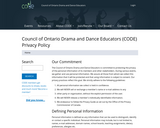
Students will use paper circuits to label various parts of the skeletal system.
- Subject:
- Biology
- Computer Science
- Engineering
- Healthful Living
- STEM
- Material Type:
- Activity/Lab
- Author:
- William Allred
- Carrie Robledo
- Date Added:
- 06/08/2021

Students will use paper circuits to label various parts of the skeletal system.

This video resource was developed by Neuroscience students of Wake Forest University. This video includes an accompanying worksheet and helps students understand the anatomy and function of the ear.

The human brain is responsible for all behaviors, thoughts, and experiences described in this textbook. This module provides an introductory overview of the brain, including some basic neuroanatomy, and brief descriptions of the neuroscience methods used to study it.

Students will develop their dance skills and learn the theoretical basis for communicating through movement. Student learning includes creating dance; scientific and safety principles, the historical development of dance; the development of an aesthetic appreciation of dance by participating in dance class, rehearsals, and performances; and the specialized vocabulary of dance criticism.

The human body is the dancer's instrument of expression. Understanding how the body works can help a dancer stay in shape, improve performance, increase confidence and add longevity to his or her performing career. It can also help a dancer avoid injury. If an injury does occur, knowledge of human anatomy can contribute to a safe process of healing and recovery.

This is a resource which allows students to review the different parts of the brain. There are quizzes available for students to take to review the information in the simulation.

This unit serves as an introduction to a course on Human Anatomy and Physiology. It gives a brief overview of how the human organism is organized, and then introduces the body's 11 body systems. Major anatomical terminology is presented in this unit including body regions, body planes, anatomical directions, and body cavities. Major survival needs are discussed along with how these needs are continually balanced within the body as the human organism uses negative and positive feedback mechanisms to maintain homeostasis.

This lesson is designed as a basic introduction into botany, and understanding the parts and functions of plants. After completion of this lesson students will have identified the main parts of plants including: roots, stems, leaves, flowers, and fruit - as well as their respective functions. This lesson is geared for a 90 minute block-schedule However, activities can and should be modified to fit within other instructional periods.

In order to understand how Duchenne’s Muscular Dystrophy affects those who have it, we must first understand muscle anatomy, how muscles contract, and the proteins involved in the process.

Let’s bring the inside out and discover how an animal’s skeleton tells us a lot about their behavior.
We have created helpful clips if you're unable to watch the full thing:
K.L.1 Bird vs. Bat Flight (16 min): https://youtu.be/FWJ6htDggqA?t=3197
3.L.1, 5.L.1 Skeletal Adaptations of a Hawk (7 min): https://youtu.be/FWJ6htDggqA?t=1080
3.L.1, 5.L.1 Bat Skeleton (3 min): https://youtu.be/FWJ6htDggqA?t=1888
3.L.1, 5.L.1 What can the skull tell us? (10 min): https://youtu.be/FWJ6htDggqA?t=2084
3.L.1, 5.L.1 Exoskeleton (2 min): https://youtu.be/FWJ6htDggqA?t=2705
3.L.1, 5.L.1 Why feces are important (2.5 min): https://youtu.be/FWJ6htDggqA?t=2981
3.L.1, 5.L.1 Turtle Shell (3 min): https://youtu.be/FWJ6htDggqA?t=3197
Animal Encounters:
1. Braveheart the Red-tailed Hawk: https://youtu.be/FWJ6htDggqA?t=1078
2. Madagascar Hissing Cockroach: https://youtu.be/FWJ6htDggqA?t=2701
3. Franklin the Eastern Box Turtle: https://youtu.be/FWJ6htDggqA?t=2701